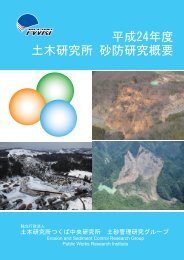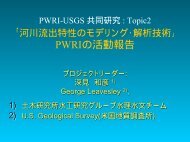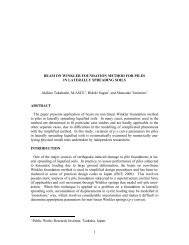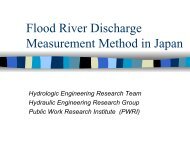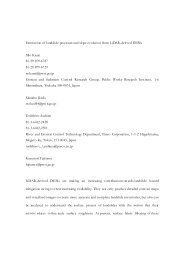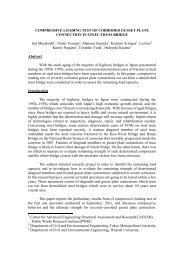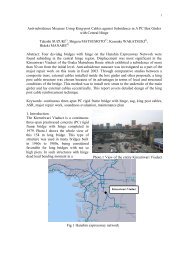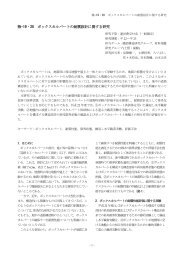Download
Download
Download
Create successful ePaper yourself
Turn your PDF publications into a flip-book with our unique Google optimized e-Paper software.
Contents of Project-22.1 Remote Sensing and Modeling ofRiver Hydrology2.2 Relations Between Flow Regime andRegional Climatic and GeophysicalConditions
Contents of 2.2 Relations Between FlowRegime and Regional Climatic andGeophysical Conditions(1) The effect of climatic variability and change onriver flow regime (flood / drought) and basin-widehydrologic processesa) Application of (1) downscaling methodology withatmospheric model and (2) XYZ precipitation andtemperature distribution methodology to explorehydrologic effectsb) Drought index study(2) The effect of land use (forest / agriculture /urbanization) and geophysical conditions on riverflow regime and basin-wide hydrologic processes
Studies at PWRIrelated to2.1 Remote Sensing and Modelingof River Hydrology
Snow water equivalent (SWE) mappingwith Synthetic Aperture Radar (SAR)aboard satelliteSnowcover extent & SWE monitoring• Estimation of water resources due to snow in ariver or dam watershed• Snow hazard prevention such as snowmelt flood,avalanche, etc. Application of microwave remote sensingDevelopment of a method to monitor snowphysical parameters such as snowcover, SWE,liquid water content, etc.
Study area (Chuetsu District of theNiigata Prefecture in Japan•••••• 2••
Field campaigns to get ground-truth ofsnow during the time of SAR-image• Observation itemsSnow depthLayer structureSnow densityLiquid watercontentSnow temperatureGrain sizeSurface roughnessTotal-layeraveraged densityaquisitions
Relationship between normalizedsummation of 0 and snow waterequivalent (FY1997 & 98 winter season)y = 1.10(x+5) 2r=0.93800700600500400300200100mmNormalized sum of 0= 0 std1+std4;with snow-{ 0 std1+std4;snow free)}Std1: standard 1 modeStd4: standard 4 mode(RADARSAT-SARobserving condition100-10 -20 -30σ 0 -400 0 Snow free is theaverage of 0 Decemberand 0 April .
Evaluation of the classification of the rank of snowwater equivalent using the retrieval algorithm RADARSATSWE ranking by RADARSAT-SAR32101.936.501.919.21.911.917.3SWE ranking by ground-based observation1.929.63.83.83SWE rankingRank 0 0mm no snow)Rank 1 0~220mmRank 2 220440mmRank 3 440mm
SWE-rank classification map(1997-98 winter season199712 19981 19982 19983 19984
Future subjects• Confirmation of the applicability to otherclimatic region (dry snow area, etc.)• Development an algorithm to remove theeffect of forest and topography (ex.Application of muti-parameter SAR?)• Connection to theoretical studies• Research budget/project finding (CREST?)
Studies at PWRIrelated to2.1 Remote Sensing and Modelingof River Hydrology
Monitoring basin-wide hydrologic / hydraulicconditions using remote sensingFor river & waterresourceplanningand managementconsideringsustainable & soundhydrologic cycle ( ) )(infiltration)(groundwater)( Heat island )Land subsidenceStructure damage InundationWake, wave & shallowsSand deposit ( )Illegally moored boat
2. River monitoring1)Super high-resolution satellite images,2) laser profiler3) TLS (three-line-scanner)
Applications of high-res. satellite data (IKONOS)to river channel & dry riverbed monitoringStructure(Drainage Gate)Utilization ofdry riverbed(cars)Land useVegetationCars on bridgesBoats,wake, wave,andshallows
Land cover classification and detectionof river channel
TLS(Three-Line Scanner Imaging System)• An optical sensor system with three CCD line sensors toacquire the three-direction images at a time• 3-dimensional topographical surveying is possible usingthe three-direction imagesComparison between TLS and other remotely-sensed imagesScanning load Digital imagesDynamic range GPS/IMU GCP necessities TLS stabilizer Post-process load Ground resolutionhelicopterGround survey loadLines & topographyFlight-dir. distortionMeasur. accuracyShaking effect removalWeather effectFollowing capacityTLSAreal photo Satellite image
Contents of TLS studies at PWRI• Topography mapping with TLSincluding riverbed beneath water surface• Detection of targets in river area• Investigation of river-bed materials (sizeddistribution of river-bed sands & gravels)• Investigation of forest height, etc.
Study sites• Middle-stream of the Arakawa-River in Kantodistrict (1.0 km long)Yorii downtownYorii ParkbridgeAcquisition 2002/1/301/31
Topography mapping with TLSwith three-line imagesOrtho imageContour lines(50cm:red)Horiz. Accuracy: 1015cmVert. Accuracy: 1520cm
Monitoring of the flood damages of river structures &environment and other targets along riversDetection of targets in river areaTLS imageGround-based photosFallen trees by floodTLS ground resolution=3.5cm (H=300m)Block structure & its broken pieces
Investigation of river-bed materials• Comparison of TLS detection with ground-basedconventional surveyPoint No.2Sampling surveyEnlarged TLS imagePoint No.1•Sampling frame33m•Diameter measurement(100 samples) Comparison of gravel diameter between TLSand ground surveyMeandiameter(cm)Major axisMedium axisMinor axisd60Groundsurvey15.5811.075.7073.66NO.1TLSestimation26.6514.82-93.79GroundSurvey5.183.802.1358.49NO.2TLSestimation14.199.99-66.64
Mapping of river-bed material & forestheight with TLS dataRiverbed gravel size classification•Under 2cm•210cm•1020cm•2080cm•2cm with grassForest canopy height•Over 20m•1520m•5m15m•Under 5m (shrub)•Under 5m (nursery tree) •Agricultural field (under 5m)
Potential to mapping riverbed topography• Contour mapping under relatively clean water• Considering the refractive index of waterContour lines beneath river waterIdentification of rapids, pools, etc. in river channels
Estimation of water budget of Tonle SapLake in CambodiaCarbonnel & Guiscafire (1962-63)Inflow fromwatershed 243Evap. 104 Rain 139Tonle Sap LakeNormal flow 729Main channnl ofThe Mekong River4,000Area of Tonle Sap Lake67,000km 2Inverse flow 450Unit of water volume 0.1 billion m 3
Main water-stage observatoriesnear the Tonle Sap LakeKompongLuongPrekKdamPhnom Penh
Ground Control Point (GCP)Remote sensingfrom satellites (and/or airplane)B1 B2B3BAA3A1A2Maximum inundated area(rainy season)Temporal change of lake areaMinimum lake area(dry season)Conversion into areal topographical dataEvaluation of the temporal variation offlood retarding capacity
Study AreaCambodia, Tonle Sap Lake Mekong Delta Upper basin
Examples of satellite dataaround the Tonle Sap Lake (Landsat- TM/ETM+)2000.3.252000.7.232000.8.162000.11.4LANDSAT TM/ETM+ RGBBand Band Band
Estimation of flood inundationof the area around the Tonle Sap Lake
Studies at PWRIrelated to2.1 Remote Sensing and Modelingof River Hydrology
BackgroundDistributed-parameter models are now regarded as anew promising tool for administrators and/orhydrologists to make any decision related tointegrated water-resource resource management consideringbasin-wide hydrologic environment and processes ina variety of temporal/spatial scales.However, the distributed models are still thought tobe very difficult to apply to operational hydrologicproblems because of the existence of manyparameters.
Approach• A priori estimation of parameters related to land-atmosphere interactions, i.e. soil and vegetationsystem, was tried usingGIS analysis. This isbased upon the idea thatA 0real situations nearA Bground surface areCrelatively easily reflectedin GIS with in situ and/orremotely-sensed data.
Development of basin-wide distributedparameterhydrologic modelStudy siteBasehydrologicmodelEvapotranspirationmoduleSoil-moistureaccountingmoduleLittleWashita, OK,USAPRMSNoilhan-Planton(N-P)PRMS originalKhlongLuang,ThailandPRMSN-PModified N-P(Ver.1)Kusaki-dam& ShiobaradamPWRI modelN-PModified N-P(Ver.2)
• Long-term river-flow simulation formountainous forested basins• Development of a GIS-based conceptualdistributed-parameter hydrologic model“Modified PWRI model”
Characteristics of hydrologicprocesses of forested hillslopeA 0ABC• Hydrologic processes inforest canopy =canopy interception,evapotranspiration• Hydrologic processes insoil of hillslope =surface runoff,infiltration, saturatedsubsurface flow,return flow,groundwater recharge
Evapotranspiration RainfallCanopyinterceptionvegetation cover InfiltrationSurface runoffSaturated conductivityRapid subsurface flowVertical structure(1-mesh) ofmodified PWRIdistributedparameterhydrologic model 1 mDPercolationN-P scheme parametersSaturated & residual water contentUnsaturated conductivitySlow subsurface flow Groundwater recharge z z , Unfconfined groundwaterrunoff 2 2 , Confined groundwaterrunoff ,
Actual evapotranspiration (Ea)= Penman-Monteith Equation
Surface resistance= Noilhan-Planton scheme (1989) • • • • • • • •
Net Radiation: Rn ’ ’” ” ’” ”
q q t
Soil moisture accounting (wet period):Gravitational infiltration &rapid subsurface flow∂S1 1= ( Si− Ecob_ perv− Qseep)∂tρ d∂S∂t2=w1ρ dw21( Si− E− Ecob _ perv− Qri − QC2Qseep = ( 1−C1 )( Si− Ecob_ perv) + ( S1−Wgeq) ρwdτQri = Qseep empirical constant0.5 for the Kusaki-dam watershed,0.1 for the Shiobara-dam watershedg)1
Hydrologic input data for themodified PWRI model• Daily precipitation• Daily-averaged averaged meteorological data– Solar duration, air temperature,humidity (vapor pressure) ,& wind velocity
Location of the254km 2Kusaki-Damwatershed (254km 2 )
Land useforestpaddy fieldOther fieldsResidenceKusaki-Dam Watershed
River-channel networks for Kusaki-Damwatershed 200m mesh
LANDSAT-TM images around the Kusaki-Dam watershedLANDSAT TM(1993.5.28)LANDSAT TM(1993.11.4)
NDVI map for the Kusaki-Dam watershed
LAI map based on LANDSAT-TM images &vegetation map for the Kusaki-Dam watershed
Vegetation cover ratio map based on LANDSAT-TMimages, land-use and vegetation maps at the Kusaki-Dam watershed
Kusaki-Dam WatershedSoil textureSurface geology
Long-termstreamflowsimulation withthe modifiedPWRI modelKusaki-damwatershed
Location of theShiobara-damwatershed (123km 2 )
Long-term streamflow simulationwith the modified PWRI model• Shiobara-dam watershed (1997)
• Short-term term river-flow simulation (floodforecasting) for mountainous forested basins• Development of a GIS-based & physically-basedtheoretical distributed-parameter hydrologicmodel“WEHY (Watershed Ecology and Hydrology)model”
Characteristics of WEHY model• Heterogeneity of hydrologic parameters andvariables are incorporated in the basicequations, I.e. areally-averaged averaged conservationequations.
INPUTSParameter valuesrelated totopography,geometry and soilcharacteristicsRainfalleventGeneralstructure ofHHP11Interception andevapotranspiration model +vertical unsaturated flow andinfiltration model (vertical 1-Ds)WEHY modelProgram forHillslopeHydrologicProcesses(Hybrid 1-Ds)Subsurfacestormflow(horizontal 1-D)Overlandflow(sheet andrill flow)(1-Ds)SNRG12Program forStreamNetwork andRegionalGroundwater(1-Ds and 2-D)Regionalgroundwater(2-D)Steam network flow (1-Ds)OUTPUTEvapotranspirationRunoff hydrograph
Model computational unitsSoilparameters
Soil depth estimationProfilesectionConvexfeatureConcavefeatureSlopeangle(degree)0-88-2525-0-88-2525-Bevel 0-88-2525-FlatplaneRank(point)+2+2+1+3+3+2+2+10ConiferforestBroad-leafforestCryptomeriajaponica etc.GrasslandFieldPaddyfieldOther+1 +2 +2 +1 +1 +2 03 4 4 3 3 4 23 4 4 3 3 4 22 3 3 2 2 3 1443321554432- +2 3 4 4 3 3 4 2554432443321443321554432332210
Field survey for ground-truth data of soil depth• Sampling locations 20 points under a variety oftopography & land cover flat, mild slope (eroded/depositedsteep slope• Survey items1,16,11 2,12,177,613 3,8185,10 Hydrologic soil depth Direction of slope Slope angle Major vegetation cover Soil-layer characteristics Micro-topography structure209,19,144,15Sampling locations 20 pointsPenetration tests
(1) Estimation with table of relative evaluationHydrologic soil depth (ground-truth data) (cm) Relative evaluation point for soil depth(3/3)Estimated hydrologic soildepth
Verification cases of WEHY modelat the Shiobara-dam watersheedEvent Starting DateEndingDate1 5/21/975/28/972 6/16/976/23/97** 8/23/989/4/983 9/12/989/21/984 10/14/9810/20/98PeakDischarge(m 3 /s)Peak TimeMax.Rain(mm/hr)TimeLag(hours)82.81 5/25 4:00 16 2322.61 6/20 17:00 39 21660.55 8/27 21:00 72 01089.27 9/16 7:00 73 1101.41 10/18 8:00 28 2• ** The observation data set for the event of 8/23/98-9/4/98was incomplete and had errors.
Flood runoff simulation by WEHY model1400120010008006004002000Discharge at Yuunohara9/12/98--9/21/989/12/98 0:009/13/98 0:009/14/98 0:009/15/98 0:009/16/98 0:009/17/98 0:009/18/98 0:009/19/98 0:009/20/98 0:009/21/98 0:009/22/98 0:00Time00.020.040.060.080.10.120.140.160.180.20.220.240.260.280.3Discharge (m 3 /sec)Rainfall Intensity (m/hr)observedSimulatedrainfall intensityDischarge at Yuunohara10/14/98 -- 10/21/98120 010080604020010/14/98 0:0010/15/98 0:0010/16/98 0:0010/17/98 0:0010/18/98 0:0010/19/98 0:0010/20/98 0:0010/21/98 0:00Discharge (m 3 /sec)Rainfall Intensity (m/hr)observedSimulatedrainfall intensityTime0.020.040.060.080.1Contributions from Different Flow Processes to Discharge at Yuunohara9/12/98--9/21/98Contributions from Different Flow Processes to Discharge at Yuunohara10/14/98 -- 10/20/9814001200100080000.050.10.1560040020000.20.250.39/12/98 0:009/13/98 0:009/14/98 0:009/15/98 0:009/16/98 0:009/17/98 0:009/18/98 0:009/19/98 0:009/20/98 0:009/21/98 0:009/22/98 0:00TimeTimeDischarge (m 3 /sec)Rainfall Intensity (m/hr)observedDirect Precip + Infilt ExcessReturn Overland FlowBase Flow Onlyrainfall intensity120100806000.020.040.06402000.080.110/14/98 0:0010/15/98 0:0010/16/98 0:0010/17/98 0:0010/18/98 0:0010/19/98 0:0010/20/98 0:0010/21/98 0:00Discharge (m 3 /sec)Rainfall Intensity (m/hr)observedDirect Precip + Infilt ExcessReturn Overland FlowBase Flow Onlyrainfall intensity
Conclusions• A priori estimation of parameters related to land-atmosphere interactions, i.e. soil and vegetationsystem, was proposed using GIS analysis.• The parameter estimation method was applied to twokinds of basin-wide hydrologic models (low flow &flood runoff), each of which has distinct features witheach other. Both the results were very successful inforested mountainous watersheds in Japan.• The above points suggest that the parameterestimation method proposed here is expected to havesome generality in a meteo-hydrologic area.
Studies at PWRIrelated to2.2 Relations Between Flow Regimeand Regional Climatic andGeophysical Conditions
General weather situation• Autumnal rain front was just over the mainisland of Japan, Honshu. Record storm in the Tokai regionSource: Aichi Prefecture(with some modification)
Outline of study1. Collect the rainfall data2. DD (depth-duration) analysis3. DA (depth-area) analysis4. Estimation of maximum DAD envelope curves forthe Tokai rainstorm Comparison with the largest storms in Japan and in theTokai region5. Optimization of DAD-curve parameters for theTokai rainstorm Quantifying DAD features in Tokai storm record
1 Collect the rainfall data Hourly rainfall 279 stations, 10-minute rainfall 155 stations
100Spatialdistribution150100150of the100200250250200100maximumsix-hour200150300350150100100rainfallintensity150150100Scale mm/6hrs
2DD (Depth-Duration) analysis• Source data1) 10 minutes rainfall 155points2) Hourly rainfall 279points• DD envelope relation expression Sherman type1) Kuwabara(1988) Ra0.52) Takara etc.(1999) Ra0.467
2DD analysis (based on 10-minute data)Railfall [mm] Tokai storm’s DD formula: Both of Kuwahara andTakara formulas werefixed by Akuhi-point data, 378mm / 6 hours Tokai Sta.Akuhi Sta.Senda Sta.KuwabaraMax(zone)KuwabaraMax (Japan)Takara Max (Tokai)Kuwabara Max (Tokai)Japan’s maximum DD (Kuwabara formula) 1,005mm/13hrs, Saigo, Nagasaki pref.area’s maximum DD (Kuwabara formula) 501mm/5hrs, Gongen-yama, Gifu pref.
2DD analysis (based on hour data)Rainfall [mm] Tokai Sta.Akuhi Sta.KuwabaraMax (zone)Kuwabara Max (Japan)Takara Max (Tokai)Kuwabara Max (Tokai) In zone, the overall rainfall records around the Nagoya Plainare smaller than those of the mountainous area. The Tokai rainstorm seems extremal at 6-12 hours scales inparticular.
3DA (Depth-Area) analysis• Source data 10minutes rainfall data,hourly rainfall data• Areal rainfall evaluation methodFixed area method( on the map of grid-rainfall data based on the ThiessenPolygons in the target area)
24-hour maximum areal rainfall extractions(43-, 98-, 196-, 391-, 785-, 1565-, 3141-, 6260-, 10614-, 14880 km 2 )
Comparison with the Japan’s maximum DAD curvesby Kuwabara (A,t)279t 0.5 exp(-0.0248t -0.414 A 0.5 ) Comparing with Japan’smaximum DAD expresssion,Tokai storm single recordDAD expression has smallerareal-rainfall decreasing ratesby area. It can be considered thatTokai storm was moreextremal in 6-12 hoursduration at larger spatial scale.We need to change the Japan’s maximum DAD enveloping curve !Questions The validity of the value of the power 0.5 for A The validity of the method of sampling of rain fields
Analysis of the Tokai-storm DAD curves The DAD plots can be explained by the expanded Horton formula.
Analysis of the Tokai-storm DAD curves Pa= a ⋅t0.5Japan’s maximum DADenvelope curves: u=0.0248 v=0.414 n=0.5exp(nu t A )−v− ⋅ ⋅It became the closest to Japan’s maximum DAD features around t6hr. General features of a certain event’s optimized DAD curves are:v is large and u is small. Areal rainfall decreasing rate with areabecomes higher as the duration gets longer. The unique feature of optimized DAD curves for the Tokai rainstorm isn is small. Areal rainfall decreasing rate with area is relatively small. DAD characteristics can be assessed quantitatively with the expanded Horton formula.
Conclusion (1 of 2)• Tokai-storm DAD characteristics was quantitativelyexplained. It illustrates that a)Tokai storm overallwas smaller than Japan’s largest level, b) DD –relations were the closest to the Japan’s maximumin 6-12 hours duration, c)regarding the DADcharacteristics,areal rainfall decreasing rate witharea were smaller than the Japan’s maximum DAD.The last point suggests the necessity to re-assess theJapan’s maximum DAD enveloping curves with theTokai rainstorm data.
Conclusion (2 of 2)• By changing the parameters in the expandedHorton DAD formula, the DAD-characteristics fora single storm event can be explained andquantified properly.• To continue such analyses in other storm caseswill allow us to understand and compare DADfeatures among various rainfall events in Japanand have effective knowledge about thegeographic zoning in terms of DAD characteristicsto estimate the largest-level storms and floods.
Future subjects• Establishment of the suitable method toextract the rain-field area• Development of a easy tool for DAD analisis• Compilation of DAD analyses on majorrainstorms in Japan• Re-analysis on the maximum DAD envelopeformula in terms of the areal-rainfalldecreasing ratio with area• Re-analysis on the regional zoning for theestimation of PMP



